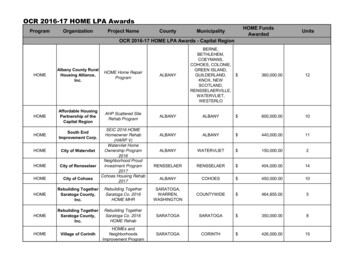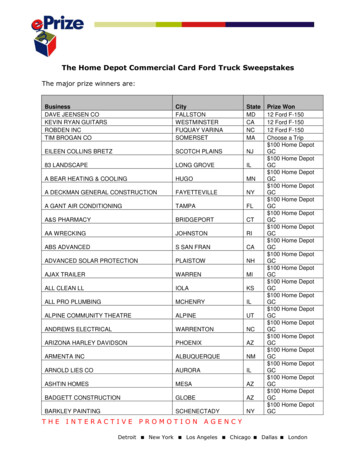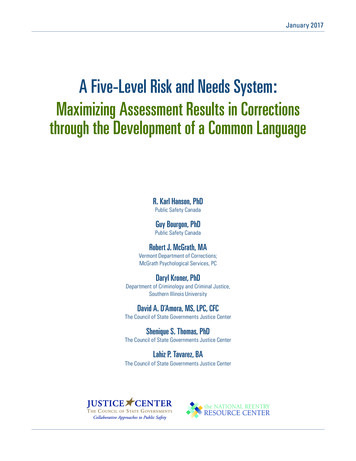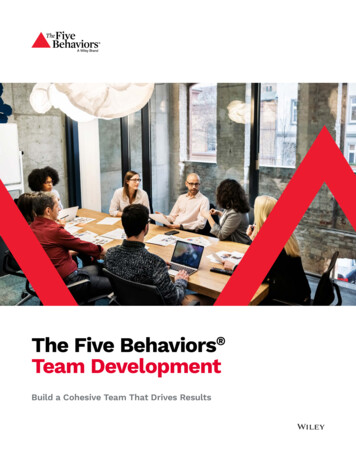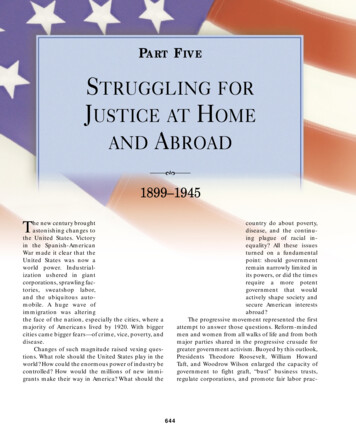
Transcription
PART F IVESTRUGGLING FORJUSTICE AT HOMEAND ABROAD 1899–1945The new century broughtastonishing changes tothe United States. Victoryin the Spanish-AmericanWar made it clear that theUnited States was now aworld power. Industrialization ushered in giantcorporations, sprawling factories, sweatshop labor,and the ubiquitous automobile. A huge wave ofimmigration was alteringthe face of the nation, especially the cities, where amajority of Americans lived by 1920. With biggercities came bigger fears—of crime, vice, poverty, anddisease.Changes of such magnitude raised vexing questions. What role should the United States play in theworld? How could the enormous power of industry becontrolled? How would the millions of new immigrants make their way in America? What should thecountry do about poverty,disease, and the continuing plague of racial inequality? All these issuesturned on a fundamentalpoint: should governmentremain narrowly limited inits powers, or did the timesrequire a more potentgovernment that wouldactively shape society andsecure American interestsabroad?The progressive movement represented the firstattempt to answer those questions. Reform-mindedmen and women from all walks of life and from bothmajor parties shared in the progressive crusade forgreater government activism. Buoyed by this outlook,Presidents Theodore Roosevelt, William HowardTaft, and Woodrow Wilson enlarged the capacity ofgovernment to fight graft, “bust” business trusts,regulate corporations, and promote fair labor prac-644
tices, child welfare, conservation, and consumerprotection. These progressive reformers, convincedthat women would bringgreater morality to politics,bolstered the decades-longstruggle for female suffrage.Women finally secured thevote in 1920 with the ratification of the NineteenthAmendment.The progressive erapresidents also challengedAmerica’s tradition of isolationism in foreign policy.They felt the country had amoral obligation to spreaddemocracy and an economic opportunity to reapprofits in foreign markets.Roosevelt and Taft launcheddiplomatic initiatives in the Caribbean, CentralAmerica, and East Asia. Wilson aspired to “make theworld safe for democracy” by rallying support forAmerican intervention in the First World War.The progressive spirit waned, however, as theUnited States retreated during the 1920s into whatPresident Harding called “normalcy.” Isolationistsentiment revived with a vengeance. Blessed with abooming economy, Americans turned their gazeinward to baseball heroes, radio, jazz, movies, andthe first mass-produced American automobile, theModel T Ford. Presidents Harding, Coolidge, andHoover backed off from the economic regulatoryzeal of their predecessors.“Normalcy” also had a brutal side. Thousands ofsuspected radicals were jailed or deported in theRed Scare of 1919 and 1920. Anti-immigrant passions flared until immigration quotas in 1924squeezed the flow of newcomers to a trickle. Raceriots scorched several northern cities in the summerof 1919, a sign of how embittered race relations hadbecome in the wake of the “Great Migration” ofsouthern blacks to wartime jobs in northern industry. A reborn Ku Klux Klan staged a comeback, notjust in the South but in the North and West as well.“Normalcy” itself soonproved short-lived, a casualty of the stock marketcrash of 1929 and the GreatDepression that followed.As Americans watchedbanks fail, and businessescollapse, and millions ofpeople lose their jobs,they asked with renewedurgency what role the government should play inrescuing the nation. President Franklin D. Roosevelt’sanswer was the “New Deal”—an ambitious array ofrelief programs, publicworks, and economic regulations that failed to curethe Depression but furnished an impressive legacyof social reforms.Most Americans came to accept an expandedfederal governmental role at home under FDR’sleadership in the 1930s, but they still clung stubbornly to isolationism. The United States did little inthe 1930s to check the rising military aggression ofJapan and Germany. By the early 1940s, eventsforced Americans to reconsider. Once Hitler’s Germany had seized control of most of Europe, Roosevelt, who had long opposed the isolationists,found ways to aid a beleaguered Britain. WhenJapan attacked the American naval base at PearlHarbor in December 1941, isolationists at last fellsilent. Roosevelt led a stunned but determinednation into the Second World War, and victory in1945 positioned the United States to assume a commanding position in the postwar world order.The Great Depression and the Second WorldWar brought to a head a half-century of debate overthe role of government and the place of the UnitedStates in the world. In the name of a struggle forjustice, Roosevelt established a new era of government activism at home and internationalismabroad. The New Deal’s legacy set the terms ofdebate in American political life for the rest of thecentury.645
28America on theWorld Stage 1899–1909I never take a step in foreign policy unless I am assured that I shallbe able eventually to carry out my will by force.THEODORE ROOSEVELT, 1905“Little Brown Brothers” in the PhilippinesLiberty-loving Filipinos assumed that they, likethe Cubans, would be granted their freedomafter the Spanish-American War. They were tragically deceived. The Senate refused to pass such aresolution granting Filipino independence. Bitterness toward the American troops mounted. It finallyerupted into open insurrection on February 4, 1899,under Emilio Aguinaldo.The war with the Filipinos, unlike the “splendid”little set-to with Spain, was sordid and prolonged. Itinvolved more savage fighting, more soldiers killed,and far more scandal. Anti-imperialists redoubledtheir protests. In their view the United States, havingplunged into war with Spain to free Cuba, was nowfighting ten thousand miles away to rivet shackles ona people who asked for nothing but liberty—in theAmerican tradition.As the ill-equipped Filipino armies were defeated,they melted into the jungle to wage vicious guerrillawarfare. Many of the outgunned Filipinos usedbarbarous methods, and the infuriated Americantroops responded in kind. A brutal soldier songbetrayed inner feelings:Damn, damn, damn the Filipinos!Cross-eyed kakiak ladrones [thieves]!Underneath the starry flagCivilize ’em with a Krag [rifle],And return us to our own beloved homes.Atrocity tales shocked and rocked the UnitedStates, for such methods did not reflect America’s646
The Filipino Insurrection647United States Possessions to 1917better self. Uncle Sam’s soldiers resorted to suchextremes as the painful “water cure”—that is, forcing water down victims’ throats until they yieldedinformation or died. Reconcentration camps wereeven established that strongly suggested those of“Butcher” Weyler in Cuba. America, having begunthe Spanish war with noble ideals, now dirtied itshands. One New York newspaper published a replyto Rudyard Kipling’s famous poem:We’ve taken up the white man’s burdenOf ebony and brown;Now will you kindly tell us, Rudyard,How we may put it down?The backbone of the Filipino insurrection wasfinally broken in 1901, when American soldiers cleverly infiltrated a guerrilla camp and capturedAguinaldo. But sporadic fighting dragged on formany dreary months.The problem of a government for the conqueredislanders worried President McKinley, who, in 1899,appointed the Philippine Commission to makeappropriate recommendations. In its second year,this body was headed by future president William H.Taft, an able and amiable lawyer-judge from Ohiowho weighed about 350 pounds. Forming a strongattachment to the Filipinos, he called them his “littlebrown brothers” and danced light-footedly withtheir tiny women. But among the American soldiers,sweatily combing the jungles, a different view of theinsurgent prevailed:He may be a brother of Big Bill Taft,But he ain’t no brother of mine.McKinley’s “benevolent assimilation” of thePhilippines proceeded with painful slowness. Millions of American dollars were poured into theislands to improve roads, sanitation, and publichealth. Important economic ties, including tradein sugar, developed between the two peoples.American teachers—“pioneers of the blackboard”—set up an unusually good school system and helped
648CHAPTER 28America on the World Stage, 1899–1909they began to tear away valuable leaseholds andeconomic spheres of influence from the Manchugovernment.A growing group of Americans viewed the vivisection of China with alarm. Churches worriedabout their missionary strongholds; manufacturersand exporters feared that Chinese markets would bemonopolized by Europeans. An alarmed Americanpublic, openly prodded by the press and slylynudged by certain free-trade Britons, demandedthat Washington do something. Secretary of StateJohn Hay, a quiet but witty poet-novelist-diplomatwith a flair for capturing the popular imagination,finally decided upon a dramatic move.In the summer of 1899, Hay dispatched to allthe great powers a communication soon known asthe Open Door note. He urged them to announcethat in their leaseholds or spheres of influence theywould respect certain Chinese rights and the idealof fair competition.The phrase Open Door quickly caught the publicfancy and gained wide acceptance. Hay’s proposalcaused much squirming in the leading capitals of theworld. It was like asking all those who did not havethieving designs to stand up and be counted. Italyalone accepted the Open Door unconditionally; itwas the only major power that had no leasehold ormake English a second language. But all this vastexpenditure, which profited America little, was illreceived. The Filipinos, who hated compulsoryAmericanization, preferred liberty. Like cagedhawks, they beat against their gilded bars until theyfinally got their freedom, on the Fourth of July, 1946.In the meantime, thousands of Filipinos emigratedto the United States (see “Makers of America: TheFilipinos,” pp. 650–651).Hinging the Open Door in ChinaExciting events had meanwhile been brewing in faraway and enfeebled China. Following its defeat byJapan in 1894–1895, the imperialistic Europeanpowers, notably Russia and Germany, moved in.Like vultures descending upon a wounded whale,The commercial interests of Britain andAmerica were imperiled by the power grabsin China, and a close concert between thetwo powers would have helped both. Yet asSecretary of State John Hay (1838–1905)wrote privately in June 1900,“Every Senator I see says, ‘For God’s sake,don’t let it appear we have any understandingwith England.’ How can I make bricks withoutstraw? That we should be compelled torefuse the assistance of the greatest power inthe world [Britain], in carrying out our ownpolicy, because all Irishmen are Democratsand some [American] Germans are fools—isenough to drive a man mad.”
The Open Door in Chinasphere of influence in China. Britain, Germany,France, and Japan all accepted, but subject to thecondition that the others acquiesce unconditionally.Russia, with covetous designs on China’s Manchuria,politely declined. But John Hay artfully interpretedthe Russian refusal as an acceptance and proclaimedthat the Open Door was in effect. Under such dubious midwifery was the infant born, and no oneshould have been surprised when the child provedto be sickly and relatively short-lived.Open Door or not, patriotic Chinese did notcare to be used as a doormat by the Europeans. In1900 a superpatriotic group known as the “Boxers”broke loose with the cry, “Kill Foreign Devils.” Overtwo hundred missionaries and other ill-fated whiteswere murdered, and a number of foreign diplomatswere besieged in the capital, Beijing (Peking).A multinational rescue force of some eighteenthousand soldiers, including twenty-five hundredAmericans, arrived in the nick of time and quelledthe rebellion. Such participation in a joint militaryoperation, especially in Asia, was plainly contrary tothe nation’s time-honored principles of nonentanglement and noninvolvement.649The victorious allied invaders acted angrily andvindictively. They assessed prostrate China anexcessive indemnity of 333 million, of which America’s share was to be 24.5 million. When Washington discovered that this sum was much more thanenough to pay damages and expenses, it remittedabout 18 million. The Beijing government, appreciating this gesture of goodwill, set aside the moneyto educate a selected group of Chinese students inthe United States. These bright young scholars laterplayed a significant role in the westernization ofAsia.Secretary Hay now let fly another paper broadside, for he feared that the triumphant powersmight use the Boxer outrages as a pretext for carvingup China outright. His new circular note to the powers in 1900 announced that henceforth the OpenDoor would embrace the territorial integrity ofChina, in addition to its commercial integrity.Defenseless China was spared partition duringthese troubled years. But its salvation was probablydue not to Hay’s fine phrases, but to the strength ofthe competing powers. None of them could trust theothers not to seek their own advantage.
The Filipinost the beginning of the twentieth century, theUnited States, its imperial muscles just flexed inthe war with Spain, found itself in possession of thePhilippines. Uncertain of how to manage this empire, which seethed resentfully against its new masters, the United States promised to build democracyin the Philippines and to ready the islanders forhome rule. Almost immediately after annexation,the American governor of the archipelago sent acorps of Filipino students to the United States, hoping to forge future leaders steeped in American wayswho would someday govern an independent Philippines. Yet this small student group found little favorin their adopted country, although in their nativeland many went on to become respected citizensand leaders.Most Filipino immigrants to the United States inthese years, however, came not to study but to toil.With Chinese immigration banned, Hawaii and thePacific Coast states turned to the Philippines forcheap agricultural labor. Beginning in 1906 theHawaiian Sugar Planters Association aggressivelyrecruited Filipino workers. Enlistments grew slowlyat first, but by the 1920s thousands of young Filipinomen had reached the Hawaiian Islands and beenassigned to sugar plantations or pineapple fields.Typically a young Filipino wishing to emigratefirst made his way to Manila, where he signed a contract with the growers that promised three years’labor in return for transportation to Hawaii, wages,free housing and fuel, and return passage at the endof the contract. Not all of the emigrants returned;there remain in Hawaii today some former fieldworkers still theoretically eligible for free transportback to their native land.Those Filipinos venturing as far as the Americanmainland found work less arduous but also less certain than did their countrymen on Hawaiian plantations. Many mainlanders worked seasonally—inwinter as domestic servants, busboys, or bellhops;in summer journeying to the fields to harvest lettuce, strawberries, sugar beets, and potatoes. Eventually Filipinos, along with Mexican immigrants,shared the dubious honor of making up California’sagricultural work force.A mobile society, Filipino-Americans also wereoverwhelmingly male; there was only one Filipinowoman for every fourteen Filipino men in California in 1930. Thus the issue of intermarriage becameacutely sensitive. California and many other statesprohibited the marriage of Asians and Caucasians indemeaning laws that remained on the books until1948. And if a Filipino so much as approached aA650
Caucasian woman, he could expect reprisals—sometimes violent. For example, white vigilantegroups roamed the Yakima Valley in Washington andthe San Joaquin and Salinas Valleys in California,intimidating and even attacking Filipinos whomthey accused of improperly accosting white women.In 1930 one Filipino was murdered and otherswounded after they invited some Caucasian womento a dance. Undeterred, the Filipinos challenged therestrictive state laws and the hooligans who foundin them an excuse for mayhem. But Filipinos, whodid not become eligible for American citizenshipuntil 1946, long lacked political leverage.After World War II, Filipino immigration accelerated. Between 1950 and 1970, the number of Filipinos in the United States nearly doubled, withwomen and men stepping aboard the new transpacific airliners in roughly equal numbers. Many ofthese recent arrivals sprang from sturdy middleclass stock and sought in America a better life fortheir children than the Philippines seemed able tooffer. Today the war-torn and perpetually depressedarchipelago sends more immigrants to Americanshores than does any other Asian nation.651
652CHAPTER 28America on the World Stage, 1899–1909Imperialism or Bryanism in 1900?President McKinley’s renomination by the Republicans in 1900 was a foregone conclusion. He hadpiloted the country through a victorious war; he hadacquired rich, though burdensome, real estate; hehad established the gold standard; and he hadbrought the promised prosperity of the full dinnerpail. “We’ll stand pat!” was the poker-playing counsel of Mark Hanna, since 1897 a senator from Ohio.McKinley was renominated at Philadelphia on aplatform that smugly endorsed prosperity, the goldstandard, and overseas expansion.An irresistible vice-presidential boom haddeveloped for “Teddy” Roosevelt (TR), the cowboy-hero of San Juan Hill. Capitalizing on his war-bornpopularity, he had been elected governor of NewYork, where the local political bosses had found himheadstrong and difficult to manage. They thereforedevised a scheme to kick the colorful colonelupstairs into the vice presidency.This plot to railroad Roosevelt worked beautifully. Gesticulating wildly, he attended the nominating convention, where his western-style cowboy hathad made him stand out like a white crow. He hadno desire to die of slow rot in the vice-presidential“burying ground,” but he was eager to prove that hecould get the nomination if he wanted it. He finallygave in to a chanting chorus of “We want Teddy!” Hereceived a unanimous vote, except for his own. Afrantic Hanna reportedly moaned that there wouldbe only one heartbeat between that wild-eyed“madman”—“that damned cowboy”—and the presidency of the United States.William Jennings Bryan was the odds-on choiceof the Democrats, meeting at Kansas City. The freesilver issue was now as defunct as an abandonedmine, but Bryan, a slave to consistency, forced a silverplank down the throats of his protesting associates.Choking on its candidate’s obstinacy, the Democraticplatform proclaimed, as did Bryan, that the paramount issue was Republican overseas imperialism.Campaign history partially repeated itself in1900. McKinley, the soul of dignity, sat safely on hisfront porch, as before. Bryan, also as before, took tothe stump in a cyclonic campaign, assailing bothimperialism and Republican-fostered trusts.The superenergetic, second-fiddle Rooseveltout-Bryaned Bryan. He toured the country withrevolver-shooting cowboys, and his popularity cutheavily into Bryan’s support in the Midwest. Flashing his magnificent teeth and pounding his fistfiercely into his palm, Roosevelt denounced all dastards who would haul down Old Glory.Bryanites loudly trumpeted their “paramount”issue of imperialism. Lincoln, they charged, hadabolished slavery for 3.5 million Africans; McKinleyhad reestablished it for 7 million Filipinos. Republicans responded by charging that “Bryanism,” notimperialism, was the paramount issue. By this accusation they meant that Bryan would rock the boat ofprosperity once he got into office with his free-silverlunacy and other dangerous ideas. The voters weremuch less concerned about imperialism than about“Four Years More of the Full Dinner Pail.”When the smoke cleared, McKinley had triumphed by a much wider margin than in 1896:
Republican Victory7,218,491 to 6,356,734 popular votes, and 292 to 155electoral votes. But victory for the Republicans wasnot a mandate for or against imperialism. Many citizens who favored Bryan’s anti-imperialism fearedhis free silver; many who favored McKinley’s “soundmoney” hated his imperialism. One citizen wrote toformer president Cleveland: “It is a choice betweenevils, and I am going to shut my eyes, hold my nose,vote, go home and disinfect myself.” If there was anymandate at all it was for the two Ps: prosperity andprotection. Content with good times, the countryanticipated four more years of a full dinner pailcrammed with fried chicken. “Boss” Platt of NewYork gleefully looked forward to Inauguration Day,when he would see Roosevelt exit Albany and “takethe veil” as vice president.653TR: Brandisher of the Big StickKindly William McKinley had scarcely servedanother six months when, in September 1901, hewas murdered by a deranged anarchist. Rooseveltbecame president at age forty-two, the youngestthus far in American history. Knowing he had a reputation for impulsiveness and radicalism, he soughtto reassure the country by proclaiming that hewould carry out the policies of his predecessor. Cynics sneered that he would indeed carry them out—to the garbage heap.What manner of man was Theodore Roosevelt,the red-blooded blue blood? Born into a wealthyand distinguished New York family, he had fiercelybuilt up his spindly, asthmatic body by a stern andself-imposed routine of exercise. Graduating fromHarvard with Phi Beta Kappa honors, he publishedat the age of twenty-four the first of some thirty volumes of muscular prose. Then came busy years,The contest over American imperialism tookplace on the Senate floor as well as aroundthe globe. In 1900 Senator Albert J. Beveridge(1862–1927), Republican from Indiana,returned from an investigative trip to thePhilippines to defend its annexation:“The Philippines are ours forever. . . . And justbeyond the Philippines are China’s illimitablemarkets. We will not retreat from either. Wewill not abandon our opportunity in theOrient. We will renounce our part in themission of our race: trustee, under God, ofthe civilization of the world.”Two years later Senator George F. Hoar(1826–1904), Republican fromMassachusetts, broke with his party todenounce American annexation of thePhilippines and other territories:“You cannot maintain despotism in Asia and arepublic in America. If you try to deprive evena savage or a barbarian of his just rights youcan never do it without becoming a savage ora barbarian yourself.”
654CHAPTER 28America on the World Stage, 1899–1909which involved duties as a ranch owner and bespectacled cowboy (“Four Eyes”) in the Dakotas, followed by various political posts. When fullydeveloped, he was a barrel-chested five feet teninches, with prominent teeth, squinty eyes, droopymustache, and piercing voice.The Rough Rider’s high-voltage energy waselectrifying. Believing that it was better to wear outthan to rust out, he would shake the hands of somesix thousand people at one stretch or ride horsebackmany miles in a day as an example for portly cavalryofficers. Not surprisingly, he gathered about him agroup of athletic, tennis-playing cronies, who werepopularly dubbed “the tennis cabinet.”Incurably boyish and bellicose, Roosevelt lovedto fight—“an elegant row.” He never ceased topreach the virile virtues and to denounce civilizedsoftness, with its pacifists and other “flubdubs” and“mollycoddles.” An ardent champion of military andnaval preparedness, he adopted as his pet proverb,“Speak softly and carry a big stick, [and] you will gofar.” If statesmen had the big stick, they could worktheir will among foreign nations without shouting; ifthey lacked it, shouting would do no good. TR hadboth a big stick and a shrill voice.Wherever Roosevelt went, there was a great stir.At a wedding he eclipsed the bride, at a funeral thecorpse. Shockingly unconventional, he loved tobreak hoary precedents—the hoarier the better. Hewas a colossal egoist, and his self-confidencemerged with self-righteousness. So sure was he ofthe correctness of his convictions that he impetuously branded people liars who disagreed with him.As a true cosmopolite, he loved people and mingledwith those of all ranks, from Catholic cardinals toprofessional prizefighters, one of whom blinded aRooseveltian eye in a White House bout.An outspoken moralizer and reformer, Roosevelt preached virtue from the White House pulpit.Yet he was an opportunist who would cut a dealrather than butt his head against a stone wall. Hewas, in reality, much less radical than his blusteryactions would indicate. A middle-of-the-roader, hestood just a little left of center and bared his mulelike molars at liberals and reactionaries alike.Roosevelt rapidly developed into a masterpolitician with an idolatrous personal following.After visiting him, a journalist wrote, “You go homeand wring the personality out of your clothes.” TR—as he was called—had an enormous popularappeal, partly because the common people saw inhim a fiery champion. A magnificent showman, hewas always front-page copy; his cowboyism, hisbear shooting, his outsize teeth, and his pince-nezglasses were ever the delight of cartoonists. Thougha staunch party man, he detested many of the dirtyhanded bosses. But he learned, as Cleveland neverdid, to hold his nose and work with them.Above all, Roosevelt was a direct-actionist. Hebelieved that the president should lead, andalthough he made mistakes, he kept things noisilymoving—generally forward. Never a lawyer, he condemned the law and the courts as too slow. He hadno real respect for the delicate checks and balancesamong the three branches of the government. Finding the Constitution too rigid, he would on occasionignore it; finding Congress too rebellious, he tried amixture of coercion and compromise on it. Thepresident, he felt, may take any action in the general
The Panama Canalinterest that is not specifically forbidden by the lawsof the Constitution. As one poet noted,The Constitution rides behindAnd the Big Stick rides before,(Which is the rule of precedentIn the reign of Theodore.)Colombia Blocks the CanalForeign affairs absorbed much of Roosevelt’s bullishenergy. Having traveled extensively in Europe, heenjoyed a far more intimate knowledge of the outside world than most of his predecessors.The Spanish-American War had emphasizedthe need for the long-talked-about canal across theCentral American isthmus, through which onlyprinter’s ink had ever flowed. Americans hadlearned a sobering lesson when the battleship Oregon, stationed on the Pacific Coast at the outbreakof war in 1898, had to steam all the way aroundSouth America to join the fleet in Cuban waters. Anisthmian canal would plainly augment the strengthof the navy by increasing its mobility. Such a waterway would also make easier the defense of suchrecent acquisitions as Puerto Rico, Hawaii, and thePhilippines, while facilitating the operations of theAmerican merchant marine.Initial obstacles in the path of the canal builderswere legal rather than geographical. By the terms ofthe ancient Clayton-Bulwer Treaty, concluded withBritain in 1850, the United States could not secureexclusive control over such a route. But by 1901America’s British cousins were willing to yieldground. Confronted with an unfriendly Europe andbogged down in the South African Boer War, theyconsented to the Hay-Pauncefote Treaty in 1901. Itnot only gave the United States a free hand to buildthe canal but conceded the right to fortify it as well.Legal barriers now removed, the next questionwas, Where should the canal be dug? Many American experts favored the Nicaraguan route, butagents of the old French Canal Company were eagerto salvage something from their costly failure atS-shaped Panama. Represented by a young, energetic, and unscrupulous engineer, Philippe BunauVarilla, the New Panama Canal Company suddenlydropped the price of its holdings from 109 millionto the fire-sale price of 40 million.655After much debate, Congress in June 1902decided on the Panama route. The scene nowshifted to Colombia, of which Panama was anunwilling part. A treaty highly favorable to theUnited States was negotiated between Washingtonand a Colombian government agent in Bogota. Itgranted to the United States a lease for a six-milewide zone in perpetuity in exchange for 10 millionand an annual payment of 250,000. The Colombian senate rejected the treaty, putting a highervalue on this precious isthmian strip. Evidence laterunearthed indicates that had Washington been willing to pay an additional 15 million, the pact wouldhave been approved.Roosevelt was infuriated by his setback at thehands of what he called “those dagoes.” Franticallyeager to be elected president “in his own right” in1904, he was anxious to “make the dirt fly” toimpress the voters. “Damn the law,” he reportedlycried in private, “I want the canal built!” He assailed“the blackmailers of Bogota” who, like armed highwaymen, were blocking the onward march of civilization. He failed to note that the U.S. Senate alsorejects treaties.Uncle Sam CreatesPuppet PanamaImpatient Panamanians, who had rebelled numerous times, were ripe for another revolt. They hadcounted on a wave of prosperity to follow construction of the canal, and they feared that the UnitedStates would now turn to the Nicaraguan route.Scheming Bunau-Varilla was no less disturbed bythe prospect of losing the company’s 40 million.Working hand in glove with the Panama revolutionists, he raised a tiny “patriot” army consisting largelyof members of the Panamanian fire department,plus five hundred “bought” Colombian troops—fora reported price of 100,000.The Panama revolution occurred on November3, 1903, with the incidental killing of a Chinese civilian and a donkey. Colombian troops were gatheredto crush the uprising, but U.S. naval forces wouldnot let the
ness toward the American troops mounted. It finally erupted into open insurrection on February 4, 1899, under Emilio Aguinaldo. The war with the Filipinos, unlike the "splendid" little set-to with Spain, was sordid and prolonged. It involved more savage fighting, more soldiers killed, and far more scandal. Anti-imperialists redoubled their .


